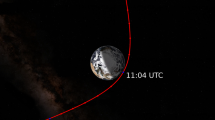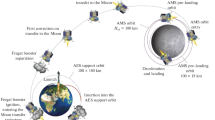Abstract
The Galileo spacecraft arrived at Jupiter in December 1995 to start its two-year mission of exploring the Jovian system, The spacecraft will complete eleven orbits around Jupiter and have ten more close encounters with the outer three Galilean satellites, after the initial close approach to lo on December 7, 1995, Since the lo encounter occurred closer to lo than originally designed, the spacecraft energy change was greater than nominally planned and resulted in an initial spacecraft orbital period about 7 days less than that designed in the nominal tour, A 100-km change in the Io-encounter distance results in an 8-day change in initial period of the spacecraft. Hence the first Ganymede encounter was moved forward one week, and the aim points for the first two Ganymede encounters were altered, but all other encounters would occur on their nominal dates and at the nominal altitudes, This was accomplished without expending spacecraft fuel and resulted in the first Ganymede flyby occurring on June 27, 1996 rather than the nominally scheduled July 4.
Earth- and spacecraft-based data were employed in developing ephemerides in support of the Galileo space mission. An analysis of CCD astrometric observations from 1992–1994, of photographic observations from 1967–1993, of mutual event astrometric data from 1973–1991, of Jovian eclipse timing data from 1652-1983, of Doppler data from 1987–1991, and of optical navigation data from the Voyager spacecraft encounter in 1979, produced the satellite ephemerides for the Galileo space mission.
Similar content being viewed by others
References
Aksnes, K. and Franklin, F.: 1976, “Mutual phenomena of the Galilean satellites in 1973”, Astron. J. 81, 464.
Aksnes, K., Franklin, F., Millis, R., Birch, B., Blanco, C., Catalano, S., and Piironen, J.: 1984, “Mutual phenomena of the Galilean and Saturnian satellites in 1973 and 1979/1980”, Astron. J. 89, 28; Astron. J. 89, 1081.
Aksnes, K., Franklin F., and Magnusson, P.: 1986, “The longitude discrepancy for mutual satellite phenomena resolved”, Astron. J. 92, 1436.
Aksnes, K.: 1993, personal communication.
Byrnes, D.V.: 1996, “Modifying the Galileo tour”, JPL Navigation Team presentation Feb 1996, JPL internal document.
D'Amario, L.A., Byrnes, D.V., Haw, R.J., Kirhofer, W.E., Nicholson, F.T., and Wilson, M.G.: 1995, “Navigation strategy for the Galileo Jupiter encounter and orbital tour”, AAS/AIAA Astrodynamics Specialist Conference, Halifax, Paper 95-381.
Franklin, F., et al, (‘Galilean Satellite Observers’): 1991, “An analysis of the 1985 observations of mutual phenomena of the Galilean satellites”, Astron. J. 102, 806.
Franklin, F,: 1993, personal communication.
Gaskell, R. W.: 1995, personal communication.
Goguen, J.D.: 1994, personal communication.
Kaas, A.A., Franklin, F., Aksnes, K., and Lieske, J.H.: 1996, “Mutual phenomena of the Galilean satellites 1990–1991”, Astron. J., in preparation.
Lieske, J.H.: 1977, “Theory of motion of Jupiter's Galilean satellites”, Astron. Astrophys. 56, 333.
Lieske, J.H.: 1980, “Improved ephemerides of the Galilean satellites”, Astron. Astrophys. 82, 340 (referred to as E2 ephemerides).
Lieske, J.H.: 1986, “A collection of Galilean satellite eclipse observations 1652–1983: Part II”, Astron. Astrophys., Suppl. Ser. 63, 143.
Lieske, J.H.: 1995a, “Making sense out of 1985 and 1991 mutual events”, Bull. Am. Astron. Soc. 27, 1197.
Lieske, J.H., 1995b, “Galilean satellite ephemerides E5”, JPL Engineering Memorandum 312–583 (20 October 1995), JPL internal publication.
Lindegren, L.: 1977, “Meridian observations of planets with a photoelectric multislit micrometer”, Astron. Astrophys. 57, 55.
Lindegren, L.: 1980, “Atmospheric limitations of narrow-field optical astrometry”, Astron. Astrophys. 89, 41–47.
Mallama, A.: 1993, “Photrometric models for Galilean satellite astronomy”, J. Geophys. Res. 98, 18873–18876.
Monet, D.G. and Monet, A.K.B.: 1992, “Galilean satellite astrometry”, U.S. Naval Observatory Flagstaf Station Memorandum.
Ostro, S.J., Campbell, D.B., Simpson, R.A., Hudson, R.S., Chandler, J.F., Rosema, K.D., Shapiro, I.I., Standish, E.M., Winkler, R., Yeomans, D.K., Velez, R., and Goldstein, R.M.: 1992, “Europa, Ganymede, and Callisto: New radar results from Arecibo and Goldstone”, J. Geophys. Res. 97, 18277.
Owen, W.M.: 1995, personal communication.
Pascu, D.: 1977, “Astrometric techniques for the observation of planetary satellites” in: Planetary Satellites (J.A. Burns, ed.), University of Arizona Press, Tucson, p. 63.
Pascu, D.: 1979, “The Naval observatory program for the astrometric observation of planetary satellites”, in: Natural and Artificial Satellite Motion (P.E. Nacozy, S. Ferraz-Mello, eds), University of Texas, Austin, p.17.
Pascu, D,: 1993, personal communication.
Pascu, D.: 1994, “An appraisal of the USNO program for photographic astrometry of bright planetary satellites”, in: Galactic and Solar System Optical Astrometry (L.V. Morrison, G.F. Gilmore, eds), Cambridge, University Press, p. 304.
Pierce, D.A.: 1974, “Observations of Jupiter's satellites”, JPL Engineering Memorandum 900-67.2.
Pickering, E.C.: 1907, “Eclipses of Jupiter's satellites”, Harvard Ann. 52, Part I, 1.
Riedel, J.E.: 1994, personal communication.
Synnott, S.P., Donegan, A.J., and Morabito, L.A.: 1982, “Position observations of the Galilean satellites from Voyager data”, JPL internal document.
Author information
Authors and Affiliations
Rights and permissions
About this article
Cite this article
Lieske, J.H. Galilean satellites and the Galileo space mission. Celestial Mech Dyn Astr 66, 13–20 (1996). https://doi.org/10.1007/BF00048819
Issue Date:
DOI: https://doi.org/10.1007/BF00048819




